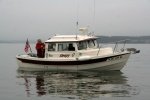Ditch bag, kept by the helm station or carried in the dinghy: I have these in one place in a bag which is waterproof, but not too bulky, so it can be easily carried.

From the upper left corner around clockwise.:
Gerber Multi tool, Red vinyl with black center for distress signal, plus about 3'/4' plastic for shelter,
3 aerial flares, smoke signal and cigarette lighter, length of para-cord, 1/8" line,
Crescent Wrench, small vise grips, foil blanket, pad of paper and pen, VHF radio--waterproof AA battery powered.
hand bearing compass, whistle, Personal Locator beacon, Manual strobe/flash light AA battery powered,
Signal mirror, fishing tackle--3 hooks, several lures, monofiliment and line,
Extra Batteries (AA), First aid kit (bandaids, betadine swabs, closure strips, telfa squares, square 30" muslim (makes two triangular bandages), Kerlex)
Not in the photo small GPS and large Swiss Army knife"Swiss Champ"
=======
I carry two to six type II PDF, depending on "crew"--when off shore just the 2 of us we have 2 type I vests. We carry 2 West Marine Belt inflatable packs, mostly used in the dinghy. We have our Vests type iii type by North Sports, may also carry 2 water ski type of type III vests if other crew. We keep two inflatable collar type of SOSpenders, with VHF radio, Strobe, Small VHF radio and whistle, clipped to the jackets, which hang by the door. There is also a Gerber multitool and Buck Sheath knife plus fire extinguisher by the cabin door.
Each person has to determine what their policy is as per life jackets aboard. On our boat all children under 16 have to have a jacket on at all times. (We have about 6 assorted sizes of children jackets at the house). Adults as they wish. Normally we do not wear jackets unless it is unusually rough, when below. If we have to go to the fore deck when underway and it is rough we have both tethers and have life jackets worn.
Strobes are manual.
We have 3 Personal Locator beacons aboard--one in the ditch bag and one each of our inflatable PDF's.
When we were crossing oceans we had one EPRIB by the companionway, and one packed in the survival gear (including food, water maker, water etc) which was in a 13 foot inflatable, which had CO2 bottles attached for rapid inflation. We also had a 10 foot rigid dinghy which had a cover packed in it--and was kept filled with fenders attached inside the boat, and easily launched from davits. We don't use a large EPRIB currently, feeling that the PLB are far more versatile, since we have our son's and daughter's phone numbers registered to the PLBs and they know if we are traveling in the RV, hiking or in the boat.


